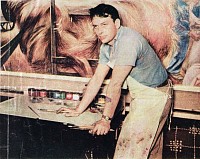BIOGRAPHY

Joe Jones, American (1909-1963)
Born in St. Louis, Missouri, April 7, 1909, and died in Morristown, New Jersey, 1963, Joe Jones was a painter and lithographer. Self taught, he quit school at age fifteen to work as a house painter.
Winning his first award in 1931, Jones gained the attention of St. Louis patrons who financed his travel to the artists' colony in Provincetown, Massachusetts. He began winning awards at age 22 in 1931 with his early paintings that are typical Midwestern Regionalist works depicting wheat fields and wheat farming.
A political activist as well as a painter, Jones organized art classes for unemployed youngsters, which he held in the old St. Louis courthouse in 1934. He alienated his supporters with the pronouncement that he had joined the Communist Party, so Jones signed up for the Public Works of Art Project in 1934.
He left St. Louis in 1935 to pursue his art career in New York. In 1937, he was awarded a prestigious Guggenheim Foundation Fellowship to create a pictorial record of conditions in the dust bowl. That same year, his work was included in a major 119 exhibition at the Carnegie Institute in Pittsburgh, PA.
Through the period of the WPA Jones was awarded five major mural commissions. As a result, he created murals for the post offices at Seneca, Kansas, Men and Wheat (1940); Anthony, Kansas, Turning a Corner (1939); Hutchinson, Kansas; Magnolia, Arkansas; and Charleston, Missouri.
During World War II he worked as a war artist for Life magazine. Because Jones addressed major political and social issues in so many of his paintings, he is typically cited as a Social Realist as well as a Regionalist. His style changed in the late 1940s to minimal and non-representational. He also worked as an instructor at St. Bernards School for Boys, Ralston, NJ.
